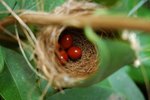
When birds make a nuisance of themselves on farms and in yards, noise can be an effective, humane repellent. Birds' hearing range is similar to that of humans, so any loud noise we can hear will probably scare them away, but they also get used to noise over time. Scaring off birds that eat crops, such as the American crow, European starling and common grackle, involves using a combination of methods, and changing them around to keep birds on their toes.
Cannon Fodder
Propane cannons, which explode propane in a firing chamber, are the most popular auditory bird repellents. Multi-shot, rotating, randomized units are more effective than single-shot units that fire in the same place, rapidly or at regular intervals. A propane cannon should be set so that the interval between shots is longer than three minutes, and the propane valves should be checked regularly for leaks, which can make the cannon fire when shut off. Supplementing propane cannon use with shotgun fire improves effectiveness, according to Colorado State University; use either shell crackers, which explode 165 to 245 feet away, or live ammunition.
Loud and Clear
Devices similar to firecrackers, called pyrotechnic cartridges, effectively clear an area of birds. Launched from a modified starter pistol, some produce a loud whistling or screaming sound as they fly through the air, and a loud bang at the end. Cartridges that are silent before a final explosion are useful for firing into a flock of flying birds so that they explode among the birds in midair, scattering them before they land. Another bird repellent based on pyrotechnics is a rope firecracker, which has a series of firecrackers along its length and a slow-burning fuse, creating explosions over a long period.
Cause for Alarm
Noise repellents for birds that don't disturb people include bird alarm calls and other noises they find unsettling. Birds make two calls that frighten other birds away: an alarm call that warns a predator is near, and a scream when they're captured. Electronic devices making these calls are effective repellents, but tend to work only for the particular species recorded. Sometimes alarm call devices also attract predators such as hawks, which scare all smaller birds away. Another auditory bird repellent makes a warbling sound that irritates birds' senses, making them feel insecure and uncomfortable. This noise can prevent the birds from communicating with each other and so cause them to leave. As well as frightening birds away from crops, alarm calls and irritating noises can prevent birds from nesting in an undesired area in spring.
Bird's-Eye View
Noise sometimes isn't the most suitable or effective repellent for birds, and others are needed. In urban areas and around livestock, using loud noises is unacceptable, and over time birds can learn to ignore such repellents. Also, some deterrents that use noise are ineffective, such as ultrasonics, which most birds are unable to hear. Alternatives and supplements to auditory bird deterrents include netting and visual deterrents, such as scare-eye balloons, streamers and flash tape. Scare-eye balloons float above crops and display an image similar to that of an open-beaked hawk. Blackbirds are particularly scared by the color yellow, and starlings are frightened of mirrors and flashing lights.
References
Resources
Photo Credits
-
David McNew/Getty Images News/Getty Images
Writer Bio
A graduate of Leeds University, Jenny Green completed Master of Arts in English literature in 1998 and has been writing about travel, gardening, science and pets since 2007. Green's work appears in Diva, Whole Life Times, Listverse, Earthtimes, Lamplight, Stupefying Stories and other websites and magazines.




